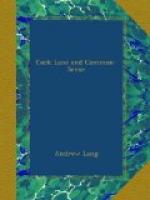However this may be, the Highland second sight is different, in many points, from the clairvoyance and magic of the Lapps, those famous sorcerers. On this matter the History of Lapland, by Scheffer, Professor of Law in Upsala, is generally cited (Oxford, 1674). ‘When the devil takes a liking to any person in his infancy,’ says Scheffer, ’he presently seizes on him by a disease, in which he haunts him with several apparitions.’ This answers, in magical education, to Smalls, or Little Go.
Some Lapps advance to a kind of mystic Moderations, and the great sorcerers attain to Final Schools, and are Bachelors in Black Arts. ’They become so knowing that, without the drum they can see things at the greatest distances; and are so possessed by the devil that they see things even against their will.’ The ‘drum’ is a piece of hollow wood covered with a skin, on which rude pictures are drawn. An index is laid on the skin, the drum is tapped, and omens are taken from the picture on which the index happens to rest. But this practice has nothing to do with clairvoyance. In Scheffer’s account of Lapp seers we recognise the usual hysterical or epileptic lads, who, in various societies become saints, mediums, warlocks, or conjurers. But Scheffer shows that the Lapp experts try, voluntarily, to see sights, whereas, except when wrapped in a bull’s hide of old, or cowering in a boiler at the present day, the Highland second-sighted man lets his visions come to him spontaneously and uninvoked. Scheffer wished to take a magical drum from a Lapp, who confessed with tears, that, drum or no drum, he would still see visions, as he proved by giving Scheffer a minute relation ’of whatever particulars had happened to me in my journey to Lapland. And he further complained, that he knew not how to make use of his eyes, since things altogether distant were presented to them.’ When a wizard is consulted he dances round till he falls, lies on the ground as if dead, and, finally, rises and declares the result of his clairvoyance. His body is guarded by his friends, and no living thing is allowed to touch it. Tornaeus was told many details of his journey by a Lapp, ’which, although it was true, Tornaeus dissembled to him, lest he might glory too much in his devilish practices’. Olaus Magnus gives a similar account. The whole performance, except that the seer is not bound, resembles the Eskimo ‘sleep of the shadow,’ more than ordinary Highland second sight. The soul of the seer is understood to be wandering away, released from his body.
The belief in clairvoyance, in the power of seeing what is distant, and foreseeing what is in the future, obviously and undeniably occurs everywhere, in ancient Israel, as in Mexico before the Spanish Conquest, and among the Red Indian tribes as among the Zulus. It is more probable that similar hallucinatory experiences, morbid, or feigned, or natural, have produced the same beliefs everywhere, than that the beliefs were evolved only by ’Aryans,’— Greeks or Scandinavians—and by them diffused all over the world, to Zulus, Lapps, Indians of Guiana, Maoris.




